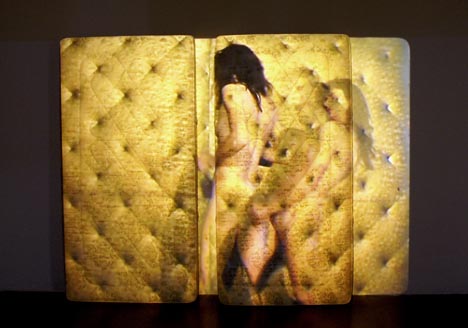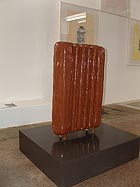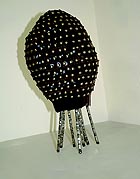
translated and summarized by: Liz Wollner-Grandville,
English summary February 15 - 20
Freiraum / quartier 21
DigitalMaterial Luzern
12.02.10 – 21.03.10
Playing with imagination
The Freiraum of the quartier 21 at the Vienna MuseumsQuartier is currently presenting 19 works by lecturers, students and graduates of the Hochschule Luzern (Luzern University). The descriptions in the catalogue differ from the personal impression on site. The audience is meant to experience a kind of workout when viewing “Wallpaper – kicking against the pricks” (2009) by Tatjana Marusic. A naked woman, at first nearly motionless, suddenly comes out of her shell and is literally duplicated. An obvious and powerful act of love follows. What is remarkable is that the protagonist does not have to touch herself at all -the dynamic cutting of the film controls the figure, as well as the viewer, up to the finale. The video is projected onto two mattresses, somewhat blurring the image, but in no way dimming the object.
A second remarkable work is “Lethe (Greek river of the Underworld, forgetfulness)” (2009) by Anna-Sabine Zürrer. The artist uses photographs, which she found, and which, through a photographic development process, disappear again. The audience can watch the process on a video shown on the floor. The photographs, which no longer exist, are mounted on the wall, but they refer to their origin. In parallel, through the reflection of the light in a water jug, a diffuse new picture develops over the empty frame – a very poetic method dealing with remembering and forgetting. “Mega Buster – War Zone Children’s Room” by the Duo Interpixel deals with the interplay of image and sound. Children are playing with toy weapons. They are filmed in prolonged time and heated up with the original soundtrack from advertisement trailers for computer games and thereby nearly become authentic. In contrast, Simone Dubler’s “The Cement Garden” (2010) leads to a contemplative audio room, with sounds emerging from an isolated and only barley audible chest. Brigitte Dätwyler’s “Hier Aktuell” (2008/09/10) employs new technologies. The insides and outsides of five I-Macs are filled with gnome-like figures. On the outside they form a group, and inside they shift as Internet-based news from one terminal to the next. Stephan Athanas’ work “Fatamorgana – Kulturbrücke Orient Okzident” (Fata Morgana – Cultural Bridge Orient and Occident) (2010) spreads individual pictures to a number of frames. His works react to the passers-by of the passage outside of the exhibition hall. With “Parmigianino nello spazio libero” (2009), Charles Moser transforms the artist into an exhibition guard.
Prisca Wüst and Sarah Bühler’s work “Wasser Porträt” (water portrait) reminds of “Liquid Views” (1992/93) by Monika Fleischmann and Wolfgang Strauss. The performance “Genesis and the Toaster” (2009/10) by Silvia Isenschmidt refers to Valie Export's work. It is also remarkable how often something is projected (Olga Titus: Our House, 2009, Lia Kraus and Marlene Hellmann: Süsser! Härter!, 2009 frölicher and bietenhader: BAROCK N ROLL, 2010). The work of the students and that of the lecturers can best be distinguished on account of these references as well as the similarities among some of the techniques.
DigitalMaterial Luzern is a noteworthy example for media art, which can successfully find its way to the canon of fine arts as Mixed Media. The individual works are coherently staged, and walking through the exhibition allows one to experience the different topics and positions. DigitalMaterial Luzern is already the third international exhibition at the Freiraum, based on a co-operation between the MuseumsQuartier and the foreign ministry. On February 25, 2010, Franziska Lingg will present her performance “En plein air…”. The performance will be followed by a discussion with Cecilia Hausheer.
By Ursula Hentschläger
Freiraum /quartier 21
1070 Vienna, Museumsplatz 1
www.quartier21.mqw.at
Galerie Bernd Kugler
Bara – Monster Grid Paintings
23.01.10 until 27.02.10
Rationally overloaded
Grids, in addition to expressive paintings and integrated real objects, dominate the new mixed media work-cycle of the Berlin-based artist and recipient of the MAK-Schindler grant, Bara. These black grid-like structures, created with colour and tape, cover every collage and literally sprawl beyond the canvas into the gallery space. Bara declared the grid or grate to his artistic principle a long time ago. He considers his “grid paintings” as a metaphor for a rational worldview.
In parallel, as a dialectic contrast, he employs an intuitive expressive work method for his monochrome colour paintings.
The integrated real objects, such as utensils to brush your teeth, Halloween masks, flacons, photos, a head casting, portraits purchased at flea markets or heaps of colourful stickers trigger a series of both positive as well as negative associations. The artist intends to point to an iconographic coexistence of overloads, which dominate authoritarian ideologies or the mechanisms of a compulsive consumer world, simultaneously forcing them apart through irritation. Motifs such as Pac Man or a casting placed on the floor, and covered with the grid-like design, leaning on to Pinhead from the horror movie Hellraisers, symbolize the functioning of an unleashed consumer world. The artist describes his grid paintings as the formal possibility of a picture-like acquisition of gorging and digesting.
The grid, which is continued on the wall and the floor practically sucks the viewer in, swallows him. Bara makes an analogy to the process of the viewer “shrinking” on account of an authoritarian system, which ultimately degrades him to an object, which, in turn, can also be consumed. The problem he addresses becomes clear through the metaphorical reversion between the painting and the viewer: the paintings take the consumer’s position. Thus the linearity of consumerism by Bara, in the sense of Baudrillard, is already suspended.
By Romana Schuler
Galerie Bernd Kugler
6020 Innsbruck, Burggraben 6 (Hörtnagelpassage)
Phone: +43 / 512/ 561 748
Fax: +43 / 512 / 561 788
email: info@galerie-kugler.at
www.galerie-kugler.at
Opening hours: Tue-Fri 10-12 a.m., 3 – 6.30 p.m., Sat: 9 a.m. – 12.30 p.m.
Galerie Area 53
DOUBLE – VOLLEY
22.01.10 – until 27.02.10
Back and forth
It may not be a new idea that artists present their work in group exhibitions without having been selected by curators. But the idea was somewhat extended by the Area 53: the gallery managers Mounty R.P. Zentara and Karin Sulimma invited their colleague Michaela Stock to jointly present four positions at the gallery. With reference to the sport in which the ball is not allowed to touch the ground, the project was named “Double Volley”.
Michaela Stock sent Christiane Spatt into the race, presenting childhood photos with a collage of toys and cuddly toys; Sabine Groschup, shown as a video projection on a stone, commands everyone to get out of her way; Michael Nitsche, whose figures created of bones and marbles are equally disturbing as his surreal drawings; and Patrick Baumüller, who lets a neon-yellow coloured rope circle around the room. This installation catches Mounty R.P. Zentara’s series “Black”: the earth, seen from outer space: a prolific combination, presented through the rotational moment of both works. In addition to presenting himself, Zentara also nominated Bruno Rey with sculptural-architectural drawings of shirts and a sculpture of a radiator, and Gabriele Cram with an installation focussing on a notebook with a story, and Ekaterina Shapiro-Obermair with a black-and-white geometrical work on paper, blended with photos depicting cities in the former Soviet Union. One could, similar to the rotation, identify the collage as one of the exhibition’s main themes.
Apart from that, the works do not have much in common. In any case, their charm mainly consists of the nonchalant back and forth between the art worlds.
By Nina Schedlmayer
Galerie Area 53
1060 Vienna, Gumpendorfer Strasse 53
email:thearea53@gmail.com
www.area53.name
Opening hours: Tue-Fri: 2.30 p.m. – 7 p.m.
MUSA – Museum auf Abruf
Stefan Glettler
22.01.10 – 25.02.10
Material art
Attractive bizarre objects, with - at a first glance - an indefinable materiality, are standing or hanging – as if they had just arrived from a different world – in the rooms of the Startgalerie. Sculptures made of iron, wood, leather and other materials, are all marked by their elaborate and skilful processing. Some of the sculptures remind of coral-like ocean forms, as shown in documentaries on deep-sea worlds.
The combination of the reduced, clear form and the sensual surface structures distinguish all of Stefan Glettler’s (born 1980) works. The artist developed the surface design as a distinct form of art. Rarely is it as exciting to simply deal with the object itself, without having to consider any meaning or context. A contextualisation would distract from the own, inherent logic, material and form of these works. Not randomly, but rather with a surprising consequence do the individual materials find their individual matching form. Leather turns into a slightly curved, soft and flexible, but in no way weak, abstraction of a fin; and wool is wound around a nearly 2 meter tall pointed object.
The artist refrains from simply choosing the most obvious forms for his objects; instead he chooses the most exciting, which explains the strong presence of the sculptures in the room.
The few paintings in the exhibition are a logical supplement to the objects and radiate their own haptic quality. However, the monochrome-abstract canvases are inconceivable without the other works.
By Wolfgang Pichler
MUSA – Museum auf Abruf
1010 Vienna, Felderstrasse 6-8, next to the city hall
Phone: +43 (0)1 4000 8400
Fax: +43 (0)1 4000 99 8400
email: musa@musa.at
www.musa.at
Opening hours: Tue – Fri: 11 a.m. – 6 p.m., Thu: 11 a.m. – 8 p.m., Sat: 11 a.m. – 8 p.m.
Mehr Texte von translated and summarized by: Liz Wollner-Grandville


 Teilen
Teilen





